The decision to hunt the African buffalo should not be taken lightly.
Its reputation as a “killer” is not hearsay. It is true. If you are going to hunt buffalo the more you know about it the better your chances will be of emerging unscathed.
An aura of apprehension and respect is aroused when the words “African buffalo” are spoken.
Referred to by some as “black death” and to others as the most dangerous animal on the dark continent, it poses challenge enough to hunt this animal with a high powered rifle. To hunt it with bow and arrow however must surely rank as one of the greatest challenges life can offer – and it can be done – with the right equipment, using the right technique, and with a liberal measure of courage and a cool head thrown in for good effect. An additional recommendation is an experienced PH armed with a heavy calibre rifle – who can hopefully shoot straight.
Are all the stories true? Buffalo bulls circling back on the hunter and waiting in ambush? Their toughness – able to absorb tens of thousands of foot pounds of energy and still keep coming? Their aggressive nature – the murderous gleam in the eye, foam flecked muzzle – and the intent to kill, dismember and destroy any man that dares cross their path?
Is it true or has the disposition of this great African beast become exaggerated? The answer to this question is yes……and – no. Let’s take a look.
Description
Belonging to the bovid family, buffalo are heavy animals and have cattle – like features: massive bodies and stout limbs. They have a shoulder height of about 120 -140cm (47-55 inches). Adult bulls weigh in at about 800kg (1,763 pounds) and cows at about 750kg (1,653 pounds). Cows are dark brown and old bulls black in colour. Young animals are reddish brown, darkening with age. Hair covering also thins as animals grow older. The neck is relatively short and thick.
Horns are heavy with a massive base, carried by both sexes, but less well developed in females. Size, general coloration, and shape of horns are variable. Bulls usually have heavier horn structure with a large boss. Cows horns are generally more slender but can grow to exceptional lengths (see below). The horns of older animals are often worn and smooth and often break off. Tails are long with a terminal tuft. The muzzle is large, broad, bare and moist. The eyes of buffalo can be intimidating. When the head is lifted to stare at an intruder the whites of the eyes show and the eyes are often red rimmed. The bulk of a buffalo’s mass is carried in the forequarters. This is reflected in the much larger front hooves.
Habitat
Buffalo show a wide range of ecological adaptation, ranging from dense forest (preferring secondary growth and clearings) to open woodland. Habitat preference includes an abundance of grazing, shade and water. Suitable grass species occur in Brachystegia, Mopane, Acacia and Baikiaea woodland and in open, vlei (marsh) areas associated with these veld types. Although buffalo will utilize open grass plains during the cooler hours of the day or during the night, they prefer moving to wooded areas during the heat of the day to rest in the shade.
Buffalo are water dependent and will generally drink twice a day. They are also partial to resting and feeding in reed beds associated with bodies of water. They enjoy wallowing in mud which helps them to regulate body temperature and to rid themselves of external parasites.
Small bull herds and lone bulls are often found in the sodic areas (“brak kolle”) adjacent to perennial and seasonal streams. In these areas one often finds seasonal pans and pools of water to which buffalo gravitate to wallow in.
Habits
In open habitat this gregarious animal may occur in herds numbering in the hundreds and at times in the thousands (Savuti in Botswana). These are generally breeding herds made of both sexes of all age groups. These large herds often split up into smaller groups for awhile and then join the large herd again. Adult and older bulls often leave the breeding herds to form small bachelor groups of 4 to 10 animals – these and old, lone bulls are often referred to as “dagga boys”. The word “dagga” refers to the mud that often encrusts these old warriors, which they pick up whilst partaking in one of their favorite pastimes – wallowing. There is a well defined hierarchy within these bachelor herds. Lone bulls will sometimes rejoin breeding herds to mate with cows in heat.
The larger herds may migrate seasonally in search of water and grazing and might split up into smaller groups to reduce competition for scarce resources.
Buffalo herds have fairly well defined home ranges which can overlap with neighboring herds. The size of home range can vary according to available resources and will also change to adapt to the different seasons.
Buffalo generally drink early morning and at sunset. They rest in available shade or in reed beds during the heat of the day.
They rest in available shade or in reed beds during the heat of the day. Bulls will often wallow at this time as well.
Reputation
Is the bad reputation of the buffalo justified? In some respects no. Buffalo are generally placid and peace loving animals – in many respects like cattle. The author of this article has had hundreds of encounters with buffalo whilst leading wilderness trails on foot in the Kruger National Park. Many of these encounters were at close range, walking trail groups within 15 – 20m of herds of up to 400 animals. What was remarkable was the curiosity of these animals. When approached at a tangent (see hunting techniques) a protective phalanx would be formed by the bulls with the cows and younger animals safely ensconced within the lager.
The bulls would stare intently at the intruders, and, with noses raised to test the air and eyes rolled back, would determine for themselves if the intrusion was perceived as a threat or not. If the intruders were regarded as a danger the bulls would stamp their feet, sweep their horns, and emit loud snorts. This behavior would then initiate a flight response from the herd who would run away from the perceived danger. Frequently herds would not feel in imminent danger and cows and young animals would then begin to poke their inquisitive noses through the protective ring of bulls. Bulls themselves would often also approach closer for a better “look see”.
If we ourselves started to feel uncomfortable because of the close proximity and closer approach of the herd it was easily turned by clapping hands and walking towards the herd. It was also important to be able to read the “mood” of the herd. Buffalo herds appear to be more nervous and skittish early morning but are far more content and “approachable” late afternoon. The small bachelor herds and lone bulls are definitely more nervous and less predictable, and caution is advocated when approaching them. They are definitely more aggressive – often without any provocation.
During culling operations and when shooting buffalo for bait during lion capture operations I have been amazed to see the type of punishment a buffalo can absorb before dying. Well placed heart / lung shots with .375 or .458 calibre rifles would not cause an animal to flinch. Only a well placed brain or neck / spinal shot would have the desired effect and drop the animal in it’s tracks. There is enough well documented evidence to support the fact that a wounded buffalo is worth it’s reputation – and then some. Take a look at some of the commercially available videos for an eye opener. Six or seven shots with 500 Nitro’s in the engine room and the beast still charges – after absorbing in excess of 30 000 foot pounds of energy!
Without doubt a wounded buffalo is definitely one of the greatest hazards one can encounter in Africa. These animals will usually head for cover when hurt and if followed up will, in most instances, charge the intruder. A charge from a wounded buffalo can only be successfully thwarted with a brain or spinal shot with a large calibre rifle.
Once initiated, a buffalo charge will not stop until either the buffalo itself or the pursuer has been terminated. A charge invariably begins with a snort. The head is held high with the buffalo peering down its nose at the intended victim. The head is dropped at the last moment to either use the boss as a battering ram or to scoop the victim with the horns. Repeated ramming and goring with the horns will follow accompanied by trampling with the massive hooves. The final conclusion to the question “are buffalo as dangerous as they are made out to be?” is yes, if you underestimate them and do not afford them the respect they are worthy of…..and no, if you understand them, are cautious and remain aware of their lethal potential.
Buffalo have fairly poor hearing. Their eyesight is reasonable but not good. The sense of smell is highly developed and it is important therefore to approach buffalo from down wind.
Feeding
Buffalo are primarily grazers but will take in a small percentage of browse. Although they will be attracted to the short green flush of burnt areas they are not as partial to this as other species. They feed readily on old grass but will avoid areas where it has been overgrazed or trampled.
They are selective grazers with a preference for assegai grass (Heteropogon contortus), white buffalo grass (Panicum coloratum), Guinea grass (Panicum maximum), red grass (Themeda triandra), and finger grasses (Digitaria spp.).
Plants on which they will occasionally browse include sickle bush (Dichrostachys cinerea), snow berry (Securinega virosa), mopane (Colophospermum mopane), and raisin bush (Grewia spp.).
Buffalo are dark skinned and their body temperature rises quickly in direct sun. When it gets too hot they will stop feeding and seek out the nearest shade where they will rest and ruminate until it cools down. About 85% of the 24 hour cycle is spent on feeding and ruminating. Feeding takes place mostly at night.
Reproduction
Cows reach reproductive status at about 3 years and some drop their first calves at 4 years although the majority calve for the first time in their 5th year. Although bulls are sexually mature by 3 years, group dynamics and dominance of older bulls seldom allow them to breed until they are in their 7th or 8th year. Cows calve every alternate year. The gestation period is 330 – 346 days. Calves weigh in at about 40kg at birth and are weaned at about 15 months. Calving can occur throughout the year but most young are born between October to April with a peak in January to February.
Hunting the Buffalo
Hunting buffalo has become a very expensive undertaking. Free ranging (not fenced in) buffalo are not available for hunting in South Africa. All are confined to game ranches (some very large in extent but nevertheless confined). To hunt free ranging buffalo one has to set your sights on Mozambique, Zimbabwe or further north. Hunting free ranging buffalo requires a lot more physical effort in terms of locating and tracking the animals.
Unfortunately with the unrelenting march of “progress” the privilege of hunting buffalo in their wild, free ranging state, will eventually be accessible to very few and if people in Africa don’t soon begin to realize that the long term value of this continent is vested in it’s last few remaining wild places it is a privilege which will sadly, in the not too distant future, disappear forever.
The trophy
Whether a full mount, shoulder mount or just the horns mounted onto a shield buffalo make impressive trophies. The massive bosses of the males are eye catching, formidable and imposing. But don’t write off the cows with their more slender horns as they can produce some stunning trophies in terms of shape and length. See Figure2.

To qualify for the record books the minimum criteria are as follows:
- Safari Club International (SCI): To qualify for inclusion into the SCI record books the total score must exceed 100. The record is 1402/8.The method of measurement is illustrated in Figure 3.
- Rowland Ward (RW): To qualify for inclusion into the RW record books the total length must exceed 45” (114.5 cm). The record is 64” (a cow).
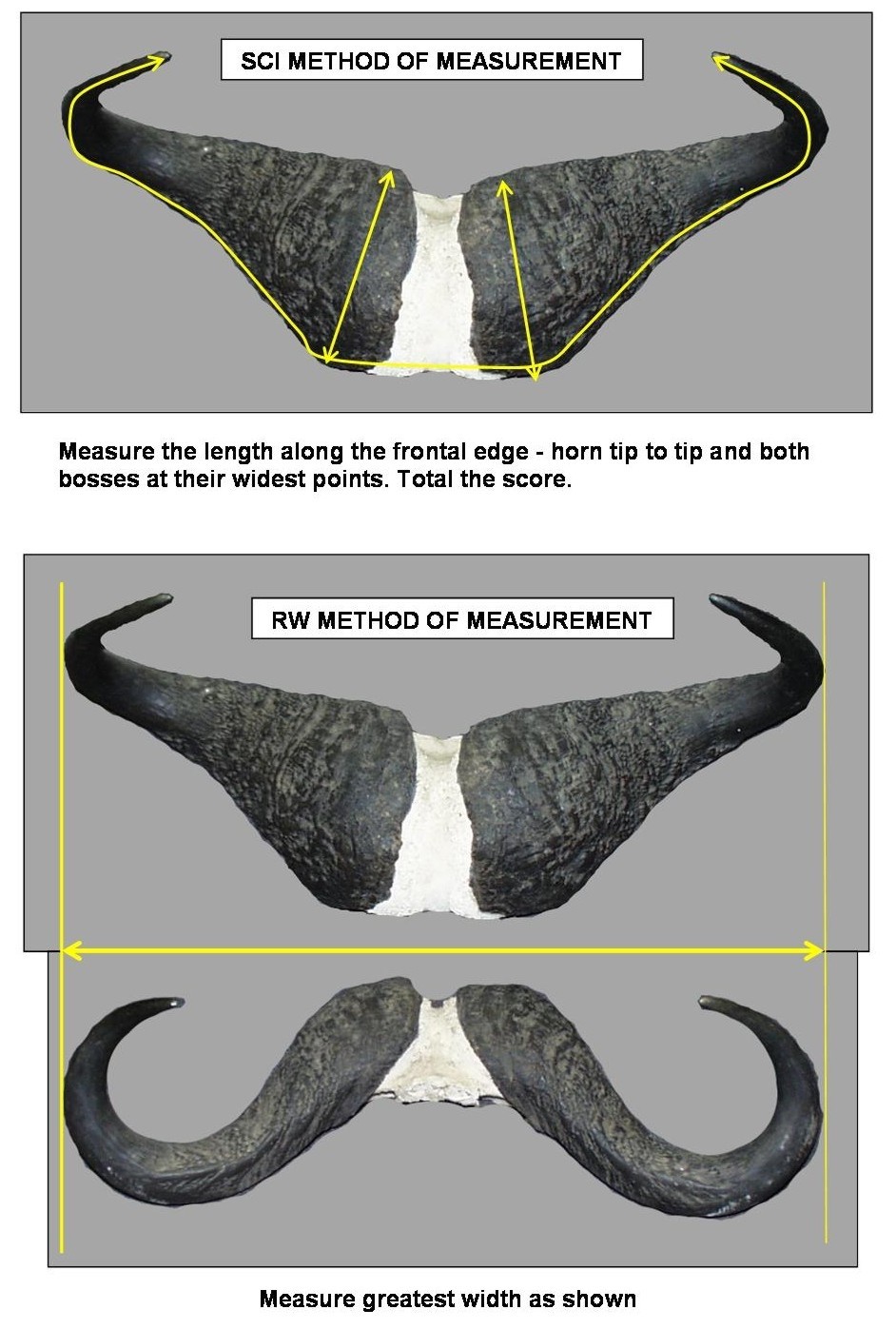
Signs to look for when hunting buffalo
It helps when looking for buffalo to know what signs to look for to indicate their presence.
Tracks
The typical large tracks of buffalo cannot be easily confused with other species. The front hooves are larger than the rear. On hard ground the dew claws will not show up in the tracks but in soft sand or mud will be clearly visible. Large herds of buffalo trample grass to a significant degree.

It is easier when following a herd of buffalo in grassy areas where tracks do not show up well by following the swathes left behind in the grass as the animals move along in file.
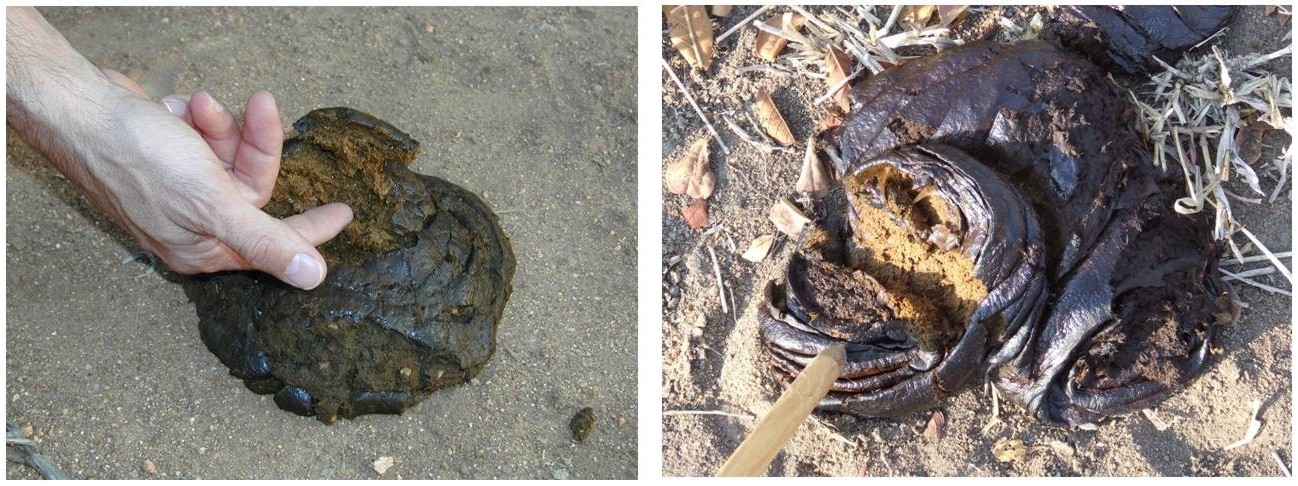
Dung
Flat pancake shape typical of cattle. Dimensions: Length 100mm. Breadth: 100mm. Olive green when fresh darkening with age to very dark brown.
Buffalo dung fresh (left) and darkening with age (right).
Rubs and horning
Buffalo will often leave “horning” sign on trees. They choose some convenient tree as an opponent and give it a good “horning” leaving it often in shreds. Sometimes old tree stumps or rocks are selected as rubbing posts to rub mud off or relieve an itch, as is sometimes the case with rhino and warthog buffalo will return to favorite rubbing posts.
Resting areas
Buffalo lie up in shady areas during the heat of the day and whilst resting at night. They leave clear sign. Grass will be flattened around the base of trees and bushes. The positions of where they have been lying, relative to that of the sun and shade at a particular time of day can also sometimes give you a clue as to when they have been there. The smell of their droppings and bodies is also very evident.
Sound
Buffalo tend, at times, to be quite vocal. As they jostle one another and sort out levels of dominance they can bellow, grunt, snort, and bash horns together. All these sounds plus the calling of calves can be heard distinctly from a long way off and serve warning to the hunter that buffalo are in the vicinity. The sight and sound of red billed ox peckers descending into or rising from a herd are also very useful indicators. Breeding herds are far noisier than bachelor herds and lone bulls that are generally very quiet. It is easy to stumble unexpectedly upon them.
Wallows
Buffalo enjoy wallowing. They often leave clear sign when walking away from ( (photo Alex Brackskowski) a wallow by dropping mud and depositing it onto vegetation which they brush up against. This is easy to follow and a useful aid in determining whether the sign is fresh or not. They also leave clear sign in mud wallows -–body impressions and tracks.
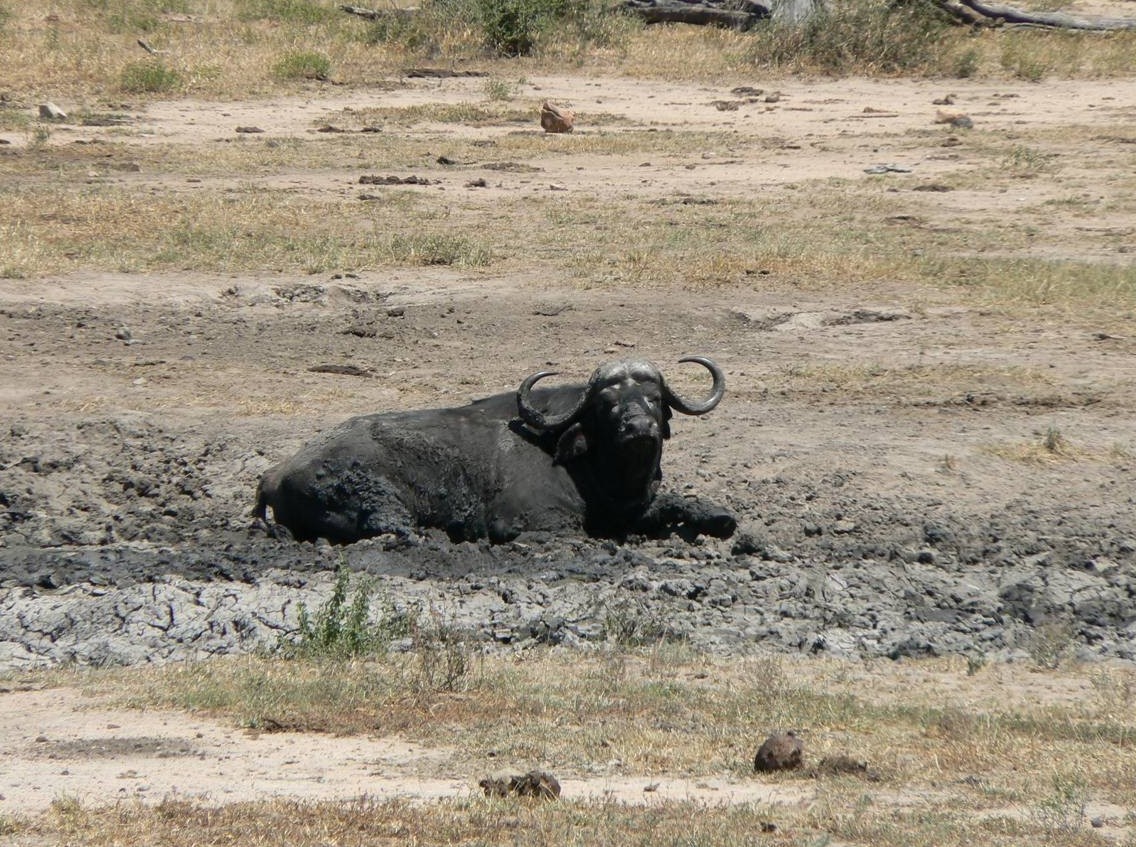
Hunting techniques
If the wind is taken into consideration and kept in the hunters favour, buffalo are one of the easier animals to hunt using walk and stalk and spot and stalk methods. A properly camouflaged hunter using wind and terrain to advantage should be able to approach to within bow range and especially rifle range with relative ease. By determining the direction in which a grazing herd is moving it is also possible to move ahead of them and wait in ambush.

Shot placement is critically important with buffalo especially with a bow as the hunter has only one option and that is a heart / lung shot. The rifle hunter has basically three options – a heart / lung shot, a neck shot and a brain shot.
Note that the yellow dots indicate what I like to refer to as the Intended Point of Impact or I.P.I. (not to be confused with the term T.P.I. which stands for Tissue Penetration Index). It must be understood that the I.P.I and the actual aiming point on the surface of an animal’s body are not necessarily, and are often not one and the same thing. That is because the aiming point shifts according to a number of criteria.
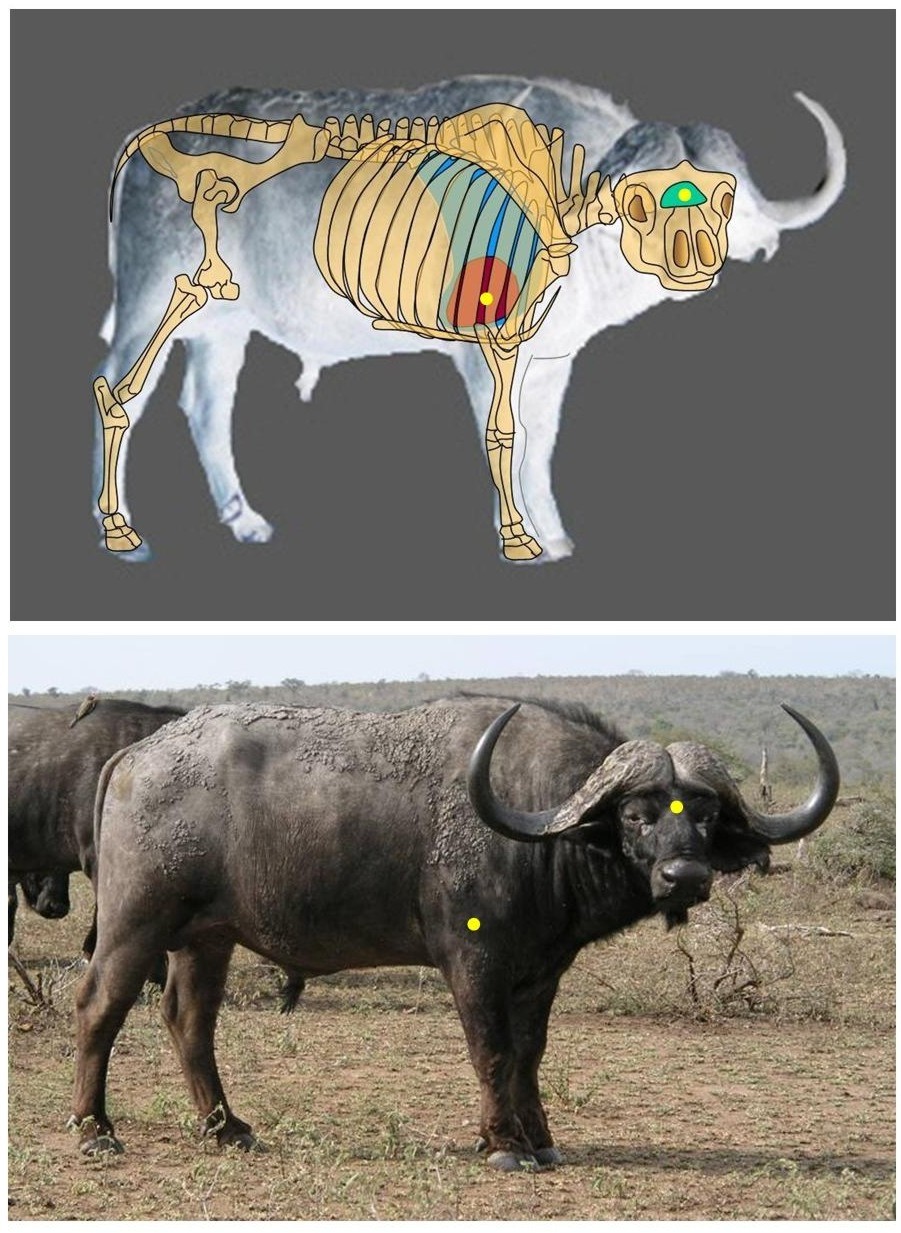
These criteria include the following:
- In a nervous or highly strung animal or of a species that is a notorious “string jumper” when hunted with a bow the aiming point can move forward by two or three inches and down by an inch or so.
This is done in anticipation of the animal lowering itself, bunching up its muscles and preparing to explode away – usually (but not always) in a forwards direction. Look at some video footage of “string jumpers” and slow the playback speed. Note how the animal lowers itself and then leaps forward at the sound of the bowstring. Here the bowhunter has to compensate for the expected reaction of the animal by shifting the aiming point. The I.P.I remains the same (the bowhunter still intends for the arrow to end up in the heart) but the aiming point shifts. - Then there is the wind factor. Now if most bowhunters stuck to shooting at 20m or less, wind deflection would be small enough, in most cases, for an arrow to still hit the vital area. If however there are bowhunters who have enough (self) confidence to attempt shots at 30, 40m or even longer distances then wind, especially crosswinds become a critical factor and the aiming point will have to be shifted to allow for wind drift. The bowhunter would have had to have spent a considerable time practicing at these sort of ranges, under similar windy conditions to know how much the arrow will drift and to know how much to “aim off”. Again the I.P.I will still be the same but the actual aiming point will have to take the wind into consideration.
The aiming point will also have to be adjusted if an animal is moving. Now ideally we should not attempt shots at moving animals but it is a fact that many bowhunters do attempt shots at non-stationary targets. As the speed of an animal increases from a slow walk through all the transitional stages up to a full run the aiming point has to be adjusted although the I.P.I. remains constant. I have a video at home where a “Pro” working for Precision Shooting Equipment (P.S.E) took a shot at a red hartebeest running at full speed past him! Fortunately the arrow passed through the hindquarters slicing through a femoral artery which left a very distinct blood trail and the animal died fairly quickly from blood loss.

Another instance in which the aiming point does not coincide with the I.P.I is where the shot is steeply uphill or downhill.
The only time where the I.P.I and aiming point would more or less coincide is under the following conditions:
1. When the animal is standing absolutely still.
2. When the shot is taken on level ground.
3. When there is little or no wind to influence arrow flight.
4. When the animal is very calm, has relatively slow reflexes and does not “string jump”.
When hunting buffalo with a bow keep the following in mind: these animals are heavy boned, have a lot of muscle mass, and a relatively thick skin. Another important consideration is that their ribs which are 10 – 15mm thick overlap one another to a large degree, presenting a significant barrier which can limit or reduce arrow penetration. The generally advocated, behind the shoulder heart / lung shot for most species, can be used in buffalo but can result in unsatisfactory penetration on occasion as the arrow must punch through the rib cage.
A better shot for buffalo is quartering away where the arrow is slipped in behind the rib cage. In this shot the arrow can penetrate deeply into the vitals without first having to pass through the ribs. For a good quartering away shot you should get within 20m or less of the animal. Aim for the opposite leg at the appropriate height. Be prepared for the unexpected when your arrow hits.
Buffalo will generally run away from the cause of their initial disturbance – but not always. Sometimes their response might be to investigate or seek out the cause of their disturbance or injury. If possible, immediately after the shot, drop out of sight or move into thick cover so that the animal does not spot you. Hunch or sit down and keep still and quiet. If the buffalo has swung to face its attacker and cannot locate the source straight away, the chances are good that it will move away, into the wind, and away from you.
If it comes for you I hope, for your sake, that you have a suitable tree nearby, and an experienced PH at hand, to cover your behind whilst you climb it. Rear end, head, neck and frontal shots should not be attempted with buffalo when using archery equipment. Some hunters have been successful with frontal shots but many have not been. Insufficient arrow penetration on hitting heavy bones of the foreleg, shoulder or brisket (sternum), being the usual problem.
Shot placement in buffalo – side on and frontal is shown by the yellow dots indicate the Intended Point of Impact. Only the heart / lung area should be aimed for when using bow and arrow. Neck and frontal brain shots are additional options for rifle hunters.
The rifle hunter using the appropriate calibre and bullet should be able to reach the vitals from a variety of angles. Remember that a heart / lung shot will not drop a buffalo in its tracks. It will run off and usually take a few minutes to expire. If it charges it will have to be dropped with a brain shot and this dictates the use of a monolithic solid to penetrate the boss and thick skull. For heart lung and neck shots soft points of suitably strong construction will work.
Follow up
A wounded buffalo is extremely dangerous. Don’t ever underestimate this animal. Even with a good heart / lung shot it can cover considerable ground before expiring. In the case of a bowhunter and assuming your shot has been a good one, wait 30 to 40 minutes before following up. If it has been a poor shot wait 4 – 5 hours. Whatever the case proceed with caution!
When injured or wounded, buffalo will rest up in heavy cover. They will be very silent. If you are following, and it is not dead, it will wait for you and when you get close enough will charge you with the intention of annihilating you.
Make sure your PH or backup is always close at hand. As you are following sign (blood, tracks or whatever) keep your eyes and ears open for oxpeckers or cattle egrets who might warn you of the animal’s whereabouts. If the animal is not dead it will in all likelihood have to be dispatched with a heavy rifle of .375 calibre or greater. If a buffalo charges it will not deviate but will follow through to its ultimate conclusion. It can only be stopped by a brain shot.
Choice of equipment
Buffalo are classified as dangerous game and for good reason. It is strongly advised that you use a bow delivering minimum kinetic energy of 80 ft. lbs. or more and an arrow weight of at least 700 grains. Ideally the arrow for hunting buffalo should be heavy (880 – 900 grains), have a shaft thinner than the ferrule of the broadhead and a strong, well constructed broadhead, with one or two blades which have a high mechanical advantage.
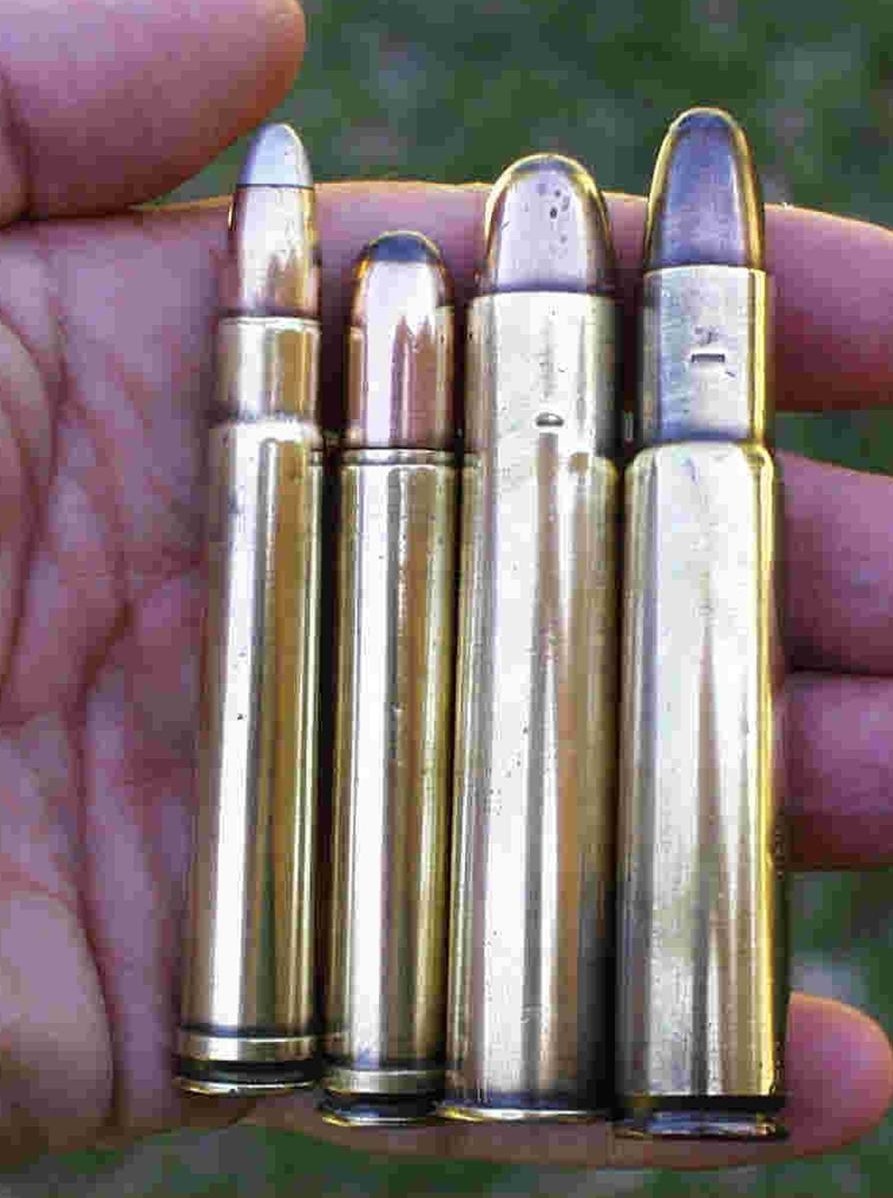
Too much emphasis is placed on kinetic energy – this is not always a good indicator of good penetration potential. Kinetic energy is scalar or non directional in nature, and includes all the types of energy of a body in motion. Kinetic energy has no direct bearing on penetration.

Momentum, however, is the correct formula to measure the directional (in this case forward) “impulse” of a body in motion. It is the force exerted over a period of time in one specific direction – i.e. a unidirectional force vector. In big, thick skinned game penetration is of vital importance and momentum is what provides it.
Do not even consider using mechanical broadheads on these robust animals.
A strongly constructed one-piece broadhead with resharpenable blades is recommended. Zwickey broadheads have a good reputation. Magnus broadheads are also a good choice.
A two-blade; cut on impact broadhead has better penetration qualities than a three or four blade option. Simmons Landshark with bleeders and Muzzy 220 grain Phantom broadhead with bleeders have good potential as well.
When hunting buffalo, use well constructed broadheads of single or two blade construction with a high mechanical advantage.
Rifle
For the rifle hunter the calibre of choice should deliver in excess of 3900 foot pounds of energy to be on the safe side and a Taylor KO Index equal to or more than 35.9.
Choices available would then include calibres such as the .375 H&H Magnum, .404 Rigby, .416 Rigby, .425 Westley Richards, .458 Winchester Magnum, .458 Lott, .460 Weatherby Magnum, .470 Nitro Express, .500 Nitro Express, .500 Jeffrey or 600 Nitro Express.
Bullets should weigh a minimum of 270 grains and be of good construction. Soft points can be considered for heart / lung and neck shots but when brain shots are considered a monolithic bullet is imperative.
When hunting buffalo make sure you have enough power in hand. Big calibres and well constructed bullets are a wise choice.
The sheer size of a buffalo, its strength, guile, and toughness make it a formidable adversary – and the privileged few who are afforded the opportunity to hunt these magnificent animals will be left with unforgettable memories.

